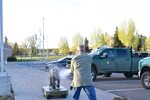KEMMERER — The Wyoming Game and Fish Department hosted a free workshop titled “Living in Large Carnivore Country” held on Thursday, May 30, at the South Lincoln Event Center in …
This item is available in full to subscribers.
To continue reading, you will need to either log in to your subscriber account, below, or purchase a new subscription.
Please log in to continue |


KEMMERER — The Wyoming Game and Fish Department hosted a free workshop titled “Living in Large Carnivore Country” held on Thursday, May 30, at the South Lincoln Event Center in Kemmerer.
As the event focused on public safety and equipping people with essential knowledge for navigating bear and lion country, the timing seemed pertinent following a recent grizzly bear sighting near Kemmerer.
Mark Aughton, large carnivore biologist and Bear Wise Wyoming coordinator for the Wyoming Game and Fish Department, emphasized the importance of the event.
“Given the recent sighting of a grizzly bear near Kemmerer, we thought this workshop would be of particular importance for refreshing the public on bear safety and the resources available to them,” he said.
Such resources include a livestock damage compensation program and on-call conflict response personnel.
With a comprehensive agenda covering safety measures and preventive strategies to minimize conflicts with grizzly bears, mountain lions, wolves, and black bears, wildlife professionals provided engaging presentations, delving into topics such as animal behavior, encounter protocols, and proper use of bear spray.
Aughton stressed that people should be aware of seasonal food sources that bears utilize and be especially vigilant to make noise to alert a bear of your presence when around these food sources. Both bears and mountain lions are opportunistic omnivores and feeding wildlife is strongly discouraged due to the increased potential to bring in predators.
While mountain lions are the most elusive of the large carnivore species in Wyoming they can be found throughout the state, though Aughton said conflicts with mountain lions are unusual. Black bears can be found anywhere within Wyoming with the highest density population centers being found within forested mountain ranges.
Grizzly bears are found in the northwest region of Wyoming, but with the species’ recovery, that population is expanding beyond suitable habitats and being seen in areas where grizzlies have been seen where they have been absent for over a century. Bears can cover large distances in a relatively short time span and sightings of grizzly bears have been confirmed in areas well outside of what is considered a current occupied range.
Aughton said, “We do not promote grizzly bear occupancy outside of suitable habitats, but it is important for people to be bear aware, for both black bears and grizzly bears, throughout northwest Wyoming including the Wyoming Range.”
A hands-on training session on the correct use of bear spray was facilitated by Safari Club International Foundation. Participants had the opportunity to practice using inert cans of bear spray on a mechanical charging “Robobear,” ensuring they are well-prepared in the event of an encounter.
With an inclusive goal for the workshop, the Game and Fish welcomed people of all ages and skill levels.
Aughton said, “This is a great opportunity for people to actively participate, ask questions and learn about the wildlife right out our back door.”
Though in most cases, bears and mountain lions avoid humans, understanding how to avoid encounters as well as bear and lion behavior is the key to safety when recreating in areas occupied by large carnivores.
A key to reducing the potential for negative encounters with carnivores is being aware and not surprising them.
“In most cases, when a grizzly bear is aggressive towards a human, they are exhibiting aggressive-defensive behavior. They react aggressively if they are defending a food source, their cubs, or their personal space,” Aughton said.
Not recreating alone and making noise to alert bears can help avoid a surprise encounter. In the event a bear feels threatened, Aughton said the best option is to play dead. This is done by lying face-down on the ground, interlocking fingers to cover the back of your neck, and spreading your legs just past shoulder-width making it more difficult for a bear to flip you onto your back. This convinces the bear that you are no longer a threat and will help to end the encounter much faster.
Aughton stressed that if a mountain lion makes physical contact with you, however, fight back with any weapons you have available to you and do not play dead.
“This demonstrates to a mountain lion you are not a typical prey item,” he said.
Listing strategies for bear and mountain lion encounters, Aughton said it is important not to panic. Be prepared to use bear spray and slowly back away while speaking in a low monotone voice.
“Stand your ground if the mountain lion or bear charges, do not run, and do not try to climb a tree,” he said.
Other things people can do to reduce the risk of a negative encounter include not recreating alone, especially during dusk and dawn.
With its focus on education and practical training, the “Living in Large Carnivore Country” workshop represented a proactive step in promoting coexistence between humans and wildlife. By equipping the community with knowledge and skills, the Wyoming Game and Fish Department hopes to ensure the safety and well-being of all who inhabit or recreate in bear and lion country.